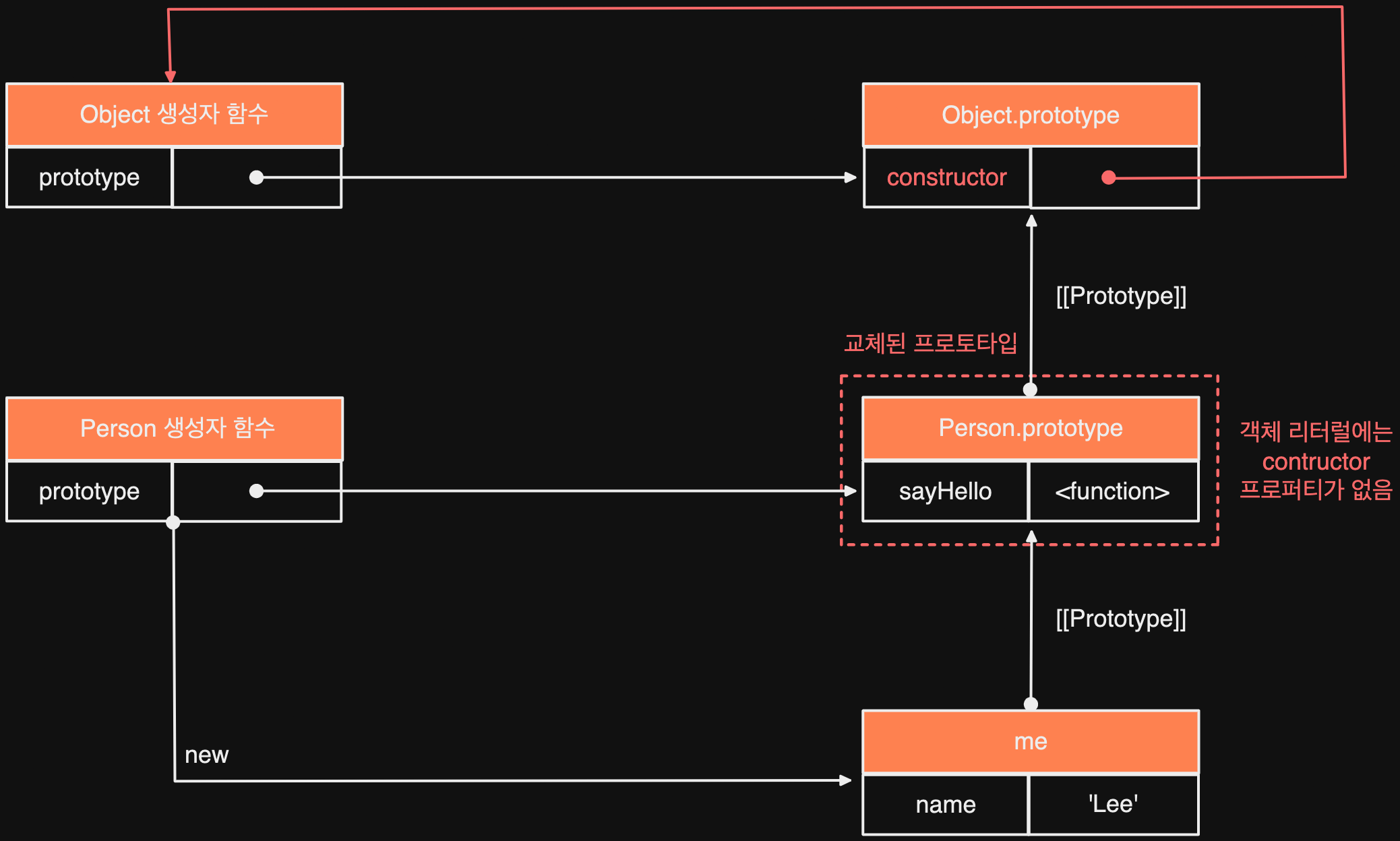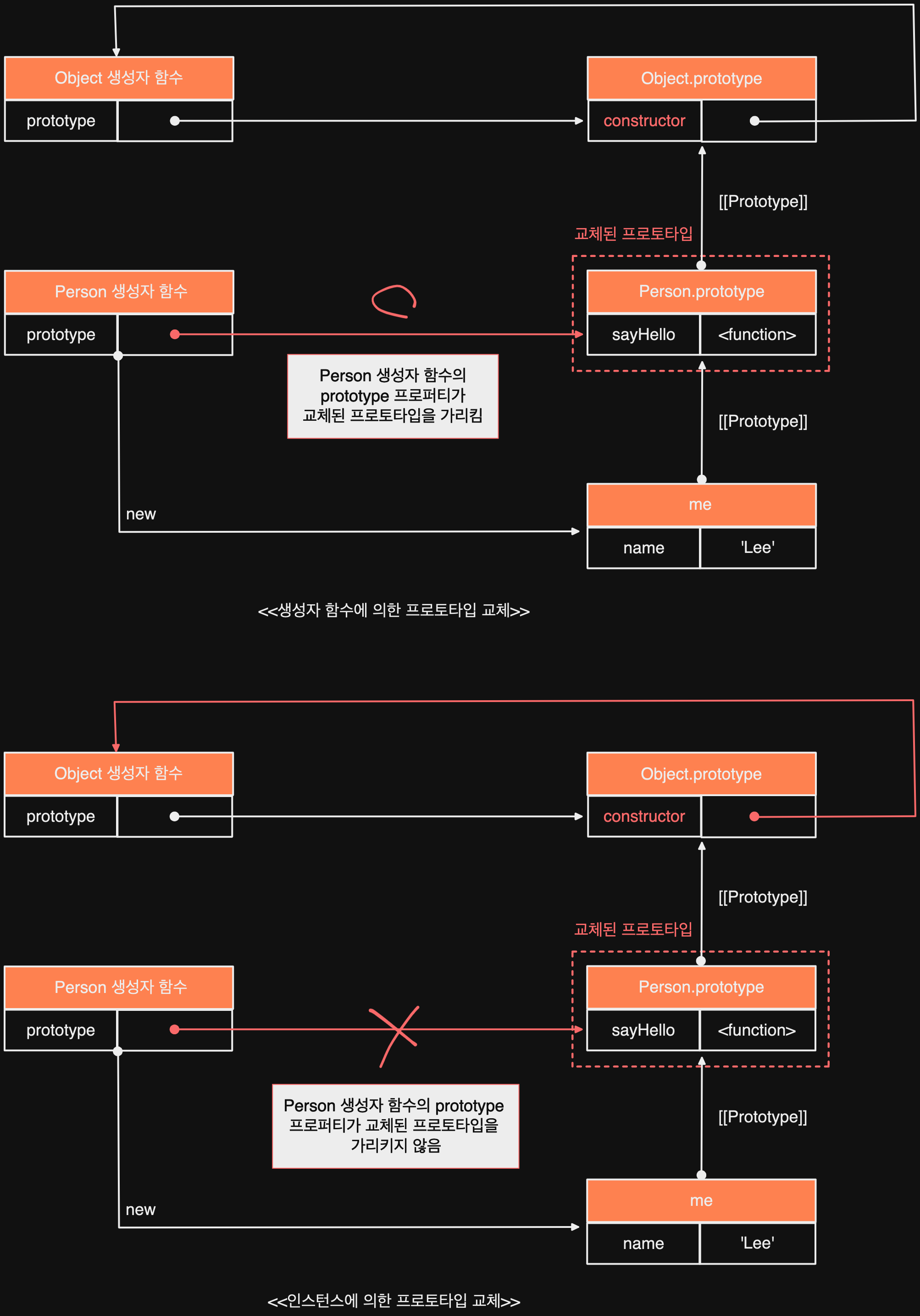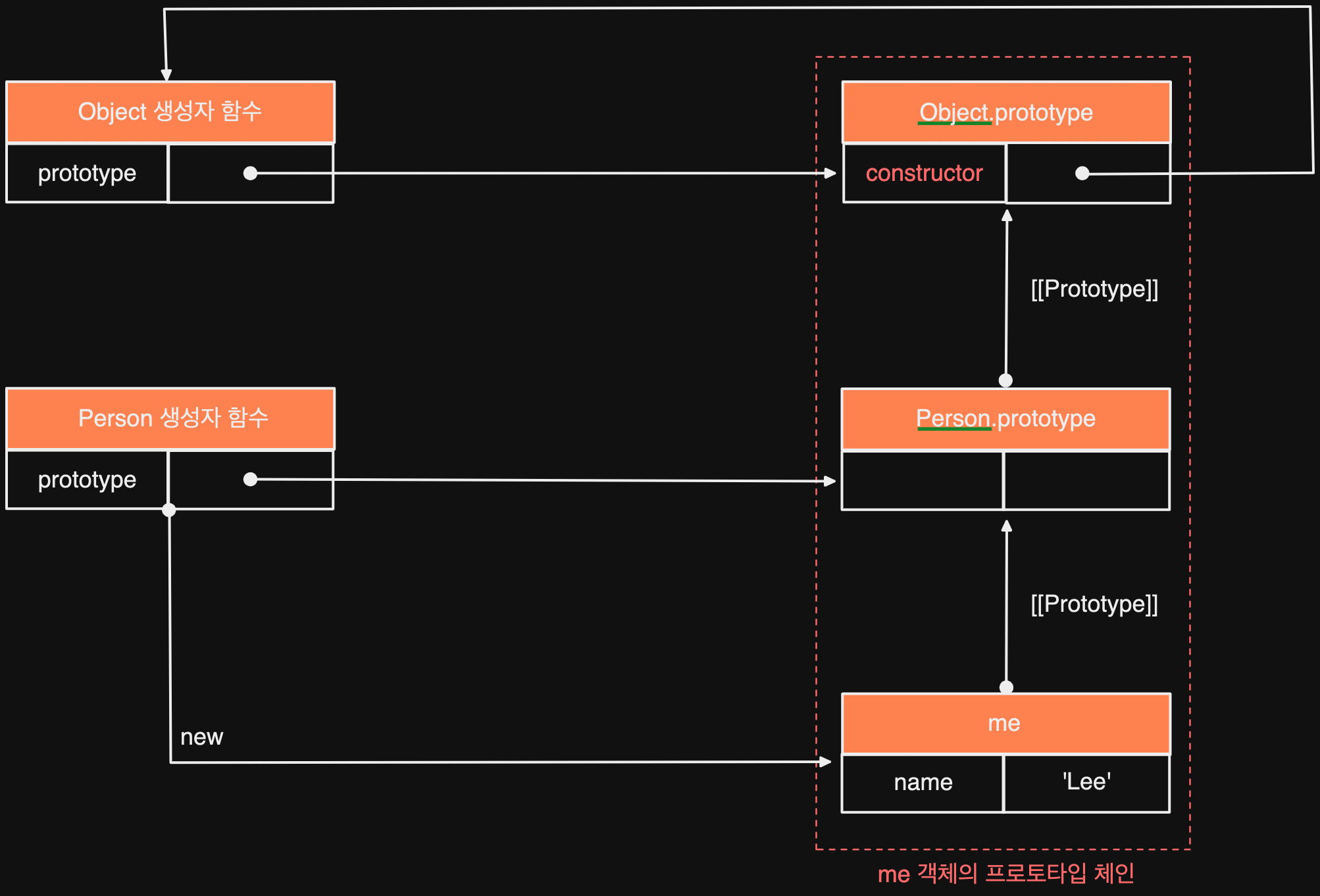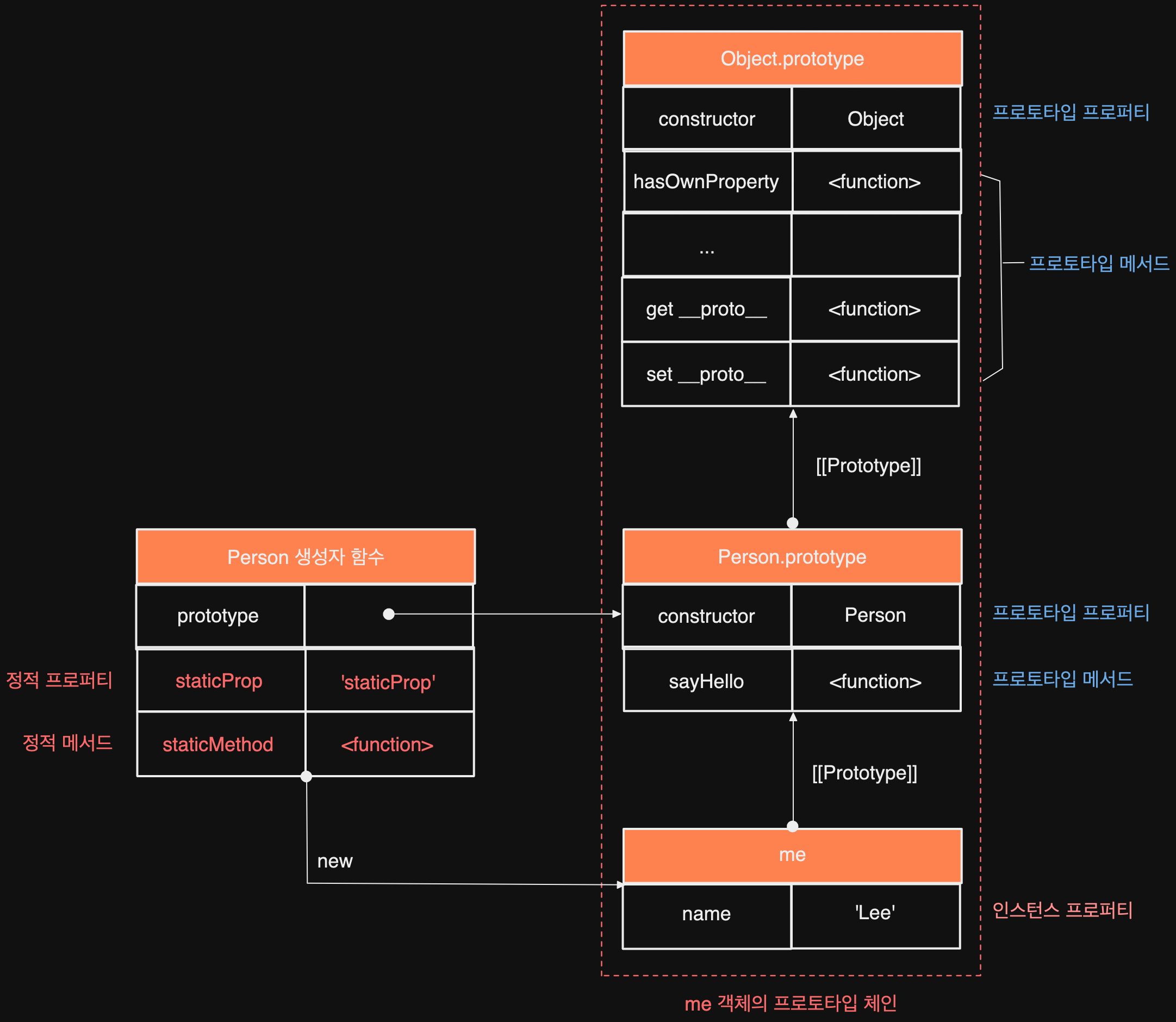- Published on
프로토타입 교체와 메서드
프로토타입 교체와 메서드
프로토타입의 교체
- 프로토타입은 임의의 다른 객체로 변경 가능
- 부모 객체인 프로토타입을 동적으로 변경할 수 있음
생성자 함수에 의한 교체
const Person = (function () {
function Person(name) {
this.name = name;
}
// 1. 생성자 함수의 prototype 프로퍼티를 통해 프로토 타입을 교체
Person.prototype = {
sayHello() {
console.log(`Hi! My name is ${this.name}`);
}
};
return Person;
}());
const me = new Person('Lee');

프로토타입으로 교체한 객체 리터럴에는
constructor 프로퍼티가 없음- 자바스크립트 엔진이 프로토타입을 생성할 때 암묵적으로 추가하므로,
me 객체의 생성자 함수를 검색하면 Person이 아닌Object가 나옴
console.log(me.constructor === Object); // true- 자바스크립트 엔진이 프로토타입을 생성할 때 암묵적으로 추가하므로,
프로토타입을 교체하면 constructor 프로퍼티와 생성자 함수 간의연결이 파괴됨
const Person = (function () {
function Person(name) {
this.name = name;
}
// 생성자 함수의 prototype 프로퍼티를 통해 프로토타입을 교체
Person.prototype = {
// constructor 프로퍼티와 생성자 함수 간의 연결 설정
constuctor: Person,
sayHello() {
console.log(`Hi! My name is ${this.name}`);
}
};
return Person;
}());
const me = new Person('Lee');
console.log(me.constructor === Person); // true
인스턴스에 의한 프로토타입의 교체
- 인스턴스의
__proto__접근자 프로퍼티를 통해 교체가 가능함
function Person(name) {
this.name = name;
}
const me = new Person('Lee');
// 프로토타입으로 교체할 객체
const parent = {
sayHello() {
console.log(`Hi! My name is ${this.name}`);
}
};
// 1. me 객체의 프로토타입을 parent 객체로 교체
Object.setPrototypeOf(me, parent);
// me.__proto__ = parent; 와 동일하게 동작함
me.sayHello();

- 생성자 함수와 마찬가지고 프로토타입의 교체로 인해서
constructor 프로퍼티와생성자 함수간의연결이 파괴됨 - 생성자 함수에 의한 프로토타입 교체와 별다른 차이가 없어보이지만 아래 그림에서 처럼 다른 차이점이 있음

instanceof 연산자
좌변에객체를 가리키는식별자,우변에생성자 함수를 가리키는 식별자를피연산자(반드시 함수)로 받음
객체 instanceof 생성자 함수
우변의 생성자 함수의 prototype에 바인딩된 객체가
좌변의 객체의 프로토타입 체인 상에 존재하면true로 평가, 그렇지 않으면false로 평가
// 생성자 함수
function Person(name) {
this.name = name;
}
const me = new Person('Lee');
console.log(me instanceof Person); // true
- Person.prototype이 me 객체의 프로토타입 체인 상에 존재하므로
true로 평가- 프로토타입이 교체되어 연결이 파괴된 경우에는
false로 평가
- 프로토타입이 교체되어 연결이 파괴된 경우에는
생성자 함수의
prototype에 바인딩된 객체가 프로토타입 체인 상에존재하는지 확인

me instanceof Person- me 객체의 프로토타입 체인 상에
Person.prototype에 바인딩된 객체의 존재 확인
- me 객체의 프로토타입 체인 상에
me instanceof Object- me 객체의 프로토타입 체인 상에
Object.prototype에 바인딩된 객체의 존재 확인
- me 객체의 프로토타입 체인 상에
instanceof함수 구현체function isInstanceOf(instance, constructor) { // 1. 프로토타입 취득 const prototype = Object.getPrototypeOf(instance); // 2. 재귀 탈출 조건 설정 // prototype이 null이면 프로토타입 체인의 종점에 다다름 if(prototype === null) return false; // 프로토타입이 생성자 함수의 prototype 프로퍼티에 바인딩된 객체라면 true 반환 // 그렇지 않다면 재귀 호출로 프로토타입 체인 상의 상위 프로토타입으로 이동하여 확인 return prototype === constructor.prototype || isInstanceOf(prototype, constructor); } console.log(isInstanceof(me, Person)); // true console.log(isInstanceof(me, Object)); // true console.log(isInstanceof(me, Array)); // false
직접 상속
Object.create에 의한 직접 상속
- 명시적으로 프로토타입을 지정하여 새로운 객체를 생성하는 방법 제공
첫 번째 매개변수- 생성할 객체의 프로토타입으로 지정할 객체 전달두 번째 매개변수(선택) - 생성할 객체의 프로퍼티 키와 프로퍼티 디스크립터 객체로 이뤄진 객체 전달
/**
* 지정된 프로토타입 및 프로퍼티를 갖는 새로운 객체를 생성하여 반환
* @param {Object} prototype - 생성할 객체의 프로토타입으로 지정할 객체
* @param {Object} [propertiesObject] - 생성할 객체의 프로퍼티를 갖는 객체
* @returns {Object} 지정된 프로토타입 및 프로퍼티를 갖는 새로운 객체
*/
Object.create(prototype[, propertiesObject])
new 연산자 없이도객체 생성 가능프로토타입을 지정하면서 객체 생성 가능- 객체 리터럴에 의해 생성된
객체 상속 가능
객체 리터럴 내부에서 __proto__에 의한 직접 상속
- ES6에서는
객체 리터럴 내부에서 접근자 프로퍼티를 사용하여직접 상속을 구현할 수 있음
const myProto = {x: 10};
// 객체 리터럴에 의해 객체를 생성하면서 프로토타입을 지정하여 직접 상속받을 수 있음
const obj = {
y: 20,
// obj -> myProto -> Object.prototype -> null
__proto__: myProto
};
console.log(obj.x, obj.y); // 10, 20
console.log(Object.getPrototypeOf(obj) === myProto); // true
정적 프로퍼티 / 메서드
- 생성자 함수로 인스턴스를 생성하지 않아도 참조/호출할 수 있는 프로퍼티/메서드
// 생성자 함수
function Person(name) {
this.name = name;
}
// 프로토타입 메서드
Person.prototype.sayHello = function () {
console.log(`Hi! My name is ${this.name}`);
};
// 정적 프로퍼티
Person.staticProp = `static prop`;
// 정적 메서드
Person.staticMethod = function () {
console.log('staticMethod');
};
const me = new Person('Lee');
// 생성자 함수에 추가한 정적 프로퍼티/메서드는 생성자 함수로 참조/호출함
Person.staticMethod(); // staticMethod
// 정적 프로퍼티/메서드는 생성자 함수가 생성한 인스턴스로 참조, 호출할 수 없음
// 인스턴스로 참조, 호출할 수 있는 프로퍼티, 메서드는 프로토타입 체인 상에 존재해야 함
me.staticMethod(); // TypeError: me.staticMethod is not a function

생성자 함수가 생성한 인스턴스는 자신의 프로토타입 체인에 속한객체의 프로퍼티/메서드에 접근할 수 있음정적 프로퍼티/메서드는 인스턴스의 프로토타입 체인에 속한 객체의 프로퍼티/메서드가 아니므로인스턴스로 접근할 수 없음- 참고
- MDN 문서에는 프로토타입 프로퍼티/메서드를 표기할 때 prototype을
#으로 표기하는 경우도 있음
- MDN 문서에는 프로토타입 프로퍼티/메서드를 표기할 때 prototype을
프로퍼티 존재 확인
in 연산자
- 객체 내에 특정 프로퍼티가 존재하는지 여부 확인
/**
* key: 프로퍼티 키를 나타내는 문자열
* Object: 객체로 평가되는 표현식
*/
key in object
// ===============================================================
const person = {
name: 'Lee',
address: 'Seoul';
};
console.log('name' in person); // true
console.log('address' in person); // true
console.log('age' in person); // false
- in 연산자는 확인 대상 객체의 프로퍼티뿐만 아니라 확인 대상 객체가
상속받은 모든 프로토타입의 프로퍼티를 확인함
person 객체가 속한 프로토타입 체인 상에 존재하는
모든 프로토타입에서 toString 프로퍼티도 존재하므로, 코드상에서 person 객체에 속하지 않아도Object.prototype의 메서드이므로true가 반환됨
Reflect.has메서드- ES6에서 도입된 in 연산자와 동일하게 동작하는 메서드
const person = {name: 'Lee'};
console.log(Reflect.has(person, 'name')); // true
console.log(Reflect.has(person, 'toString')); // true
Object.prototype.hasOwnProperty 메서드
- 객체의 특정 프로퍼티가 존재하는지 확인할 수 있음
console.log(person.hasOwnProperty('name')); // true
console.log(person.hasOwnProperty('age')); // false
- in 연산자와 달리, 인수로 전달받은 프로퍼티 키가 객체
고유의 프로퍼티 키인 경우에만true반환
console.log(person.hasOwnProperty('toString')); // false
프로퍼티 열거
for…in 문
- 객체의 모든 프로퍼티를 순회하며 열거하는 구문
// for(변수선언문 in 객체) {...}
const person = {
name: 'Lee',
address: 'Seoul';
};
for (const key in person) {
console.log(key + ': ' + person[key]);
}
// name: Lee
// address: Seoul
객체의
프로퍼티 개수만큼 순회하여 선언한 변수에프로퍼티 키를 할당함열거할 때 순서를 보장하지 않지만대부분의 모던 브라우저는 순서를 보장함상속받은 프로토타입의
프로퍼티까지 열거할 수 있음- toString과 같은 Object.prototype의 프로퍼티는
[[Enumerable]]의 값이false이므로 열거되지 않음
console.log(Object.getOwnPropertyDescriptor(Object.prototype, 'toString')); // {value: f, writable: true, enumerable: false, configurable: true}- toString과 같은 Object.prototype의 프로퍼티는
for … in 문은 객체의 프로토타입 체인 상에 존재하는 모든 프로토타입의 프로퍼티 중에서 프로퍼티 어트리뷰트
[[Enumerable]]의 값이true인프로퍼티를 순회하며 열거함
- 일반적으로
for문,for … of,Array.prototype.forEach메서드를 사용할 것을권장
Object.keys/values/entries 메서드
객체의 자신의 고유 프로퍼티만 열거하기 위한 메서드
Object.keys객체 자신의 열거 가능한
프로퍼티 키를 배열로 반환const person = { name: 'Lee', address: 'Seoul', __proto__: {age: 20} }; console.log(Object.keys(person)); // ["name", "address"]
Object.valuesES8에 도입된 메서드로서, 객체 자신의 열거 가능한
프로퍼티 값을 배열로 반환console.log(Object.values(person)); // ["Lee", "Seoul"]
Object.entriesES8에 도입된 메서드로서, 객체 자신의 열거 가능한
프로퍼티 키, 값의 쌍의 배열을배열에 담아 반환console.log(Object.entries(person)); // [["name", "Lee"], ["address", "Seoul"]] Object.entries(person).forEach(([key, value]) => console.log(key, value)); /* name Lee address Seoul */
Referenced
- 이응모, 『모던 자바스크립트 Deep Dive』, 위키북스(2022.4.25), 290 ~ 312p